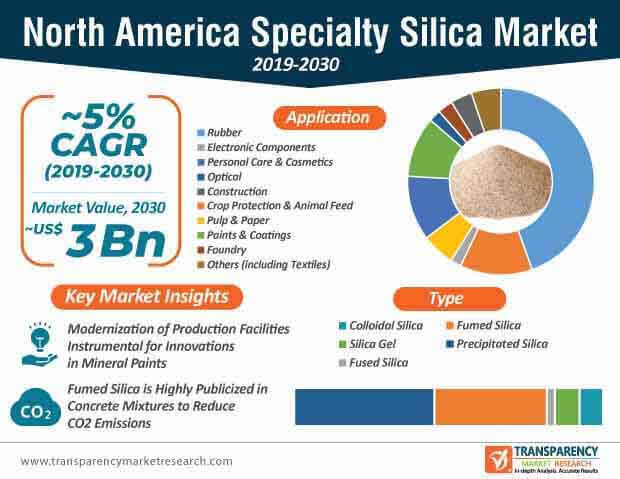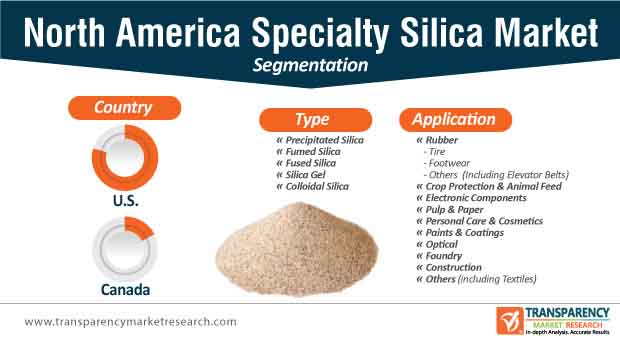The demand for high performance rubber is surging, especially with rapid growth of the automotive sector. Hence, specialty silica is used as a reinforcement filler in tire rubber applications in order to improve tire performance. This is evident since rubber is estimated to dictate the highest revenue among all applications in the North America specialty silica market, where the market is expected to cross the revenue mark of ~US$ 3 Bn by the end of 2030.
Conventional silica grades have poor dispersion in the tire rubber matrix. Hence, companies in the North America specialty silica market are increasing their production capabilities to tap into incremental opportunities in rubber applications, since the revenue of rubber is projected for exponential growth during the forecast period. As such, manufacturers are increasing their R&D capabilities to produce small particle size of specialty silica with reduced aggregates to deploy excellent external surface area to rubber tires.

Companies in the North America specialty silica market need to adopt innovative strategies to boost their revenue growth. For instance, in April 2019, BASF— a global leader and marketer of chemicals, announced to invest a mid-range double-digit euro million sum in the modernization of its silica plant at their Düsseldorf-Holthausen site. Thus, companies in the North America specialty silica market should take cues from leading market players to gain a competitive edge in the global market landscape.
Manufacturers should increase investments in capacity additions to unlock incremental opportunities in the field of crop protection and the paints & coatings industry. The trend of modernization of existing production facilities plays an instrumental role in the production of high-value specialty silica. By modernizing manufacturing plants, companies in the market can focus on exports in regions where there is a high demand for silica such as the Western European markets. As such, manufacturers are tapping into incremental opportunities in thickeners used in mortars, foundry molds, and mineral paints to broaden their revenue streams.
Apart from rubber and crop protection applications, companies in the North America specialty silica market are unearthing revenue opportunities in the construction sector. Fumed silica or micro silica is gaining popularity for improving the mechanical properties of concrete. This explains why fumed silica is estimated to register the second-highest revenue among all specialty silica types in the North America specialty silica market. However, silica fume concrete is under scrutiny for large shrinkage rates. As such, high bond strength to concrete offset adds to the disadvantage of large shrinkage rates.
The demand for specialty silica is expected to surge since overuse of cement has become a major environmental concern. Hence, companies in the North America specialty silica market are capitalizing on this trend to increase the availability of fumed silica. Fumed silica is being highly publicized to reduce CO2 emissions and improve strength and durability of concrete. On the other hand, precipitated silica is acquiring prominence in the manufacturing of tires and surface sealants for the construction industry. Detergents and cleaning agents are also expected to account for a significant share.
Specialty chemical and material providers in the North America specialty silica market are taking a step forward to join the fight against coronavirus (COVID-19). They are working closely with medical equipment OEMs to avoid any disruptions in supply chains. Unprecedented demand for PPE (Personal Protective Equipment) and other medical devices has highlighted the importance of specialty silica.
Since silica is used in the production of electronic components, companies in the North America specialty silica market are leveraging opportunities in the production of ventilator components. They are increasing efforts to deliver technologies in components of trucks that are used for transportation and in medical supplied used by frontline healthcare workers.

Analysts’ Viewpoint
Promising business potentials in developing ventilator and other electronic components are helping companies in the North America specialty silica market to join the fight against COVID-19. Manufacturers are increasing the availability of both powder and granulated forms of precipitated silica used in the production of oral care products, agrochemicals, and adhesives.
Fumed silica improves abrasion resistance in concrete. However, condensed silica fume has a large surface area, demanding the need for increased volumes of water and plasticizer, resulting in increased costs for builders. Hence, companies should increase awareness about high electrical resistivity and reduced CO2 emissions of fumed silica that help to offset costs of large surface area.
1. Executive Summary
1.1. North America Specialty Silica Market Outlook
1.2. Demand Side Trends
1.3. Key Facts and Figures
1.4. Trends Impacting Market
1.5. TMR’s Growth Opportunity Wheel
2. Market Overview
2.1. Market Segmentation
2.2. Key Developments/Product Timeline
2.3. Key Market Indicators/Definitions
2.4. Market Dynamics
2.4.1. Drivers
2.4.2. Restraints
2.4.3. Opportunities
2.5. North America Specialty Silica Market Analysis and Forecast, 2019
2.5.1. North America Specialty Silica Market Volume (Kilo Tons)
2.5.2. North America Specialty Silica Market Value (US$ Mn)
2.6. Porters Five Forces Analysis
2.7. Regulatory Landscape
2.8. Value Chain Analysis
2.8.1. List of Key Manufacturers
2.8.2. List of Potential Customers
3. North America Production Output Analysis, 2019–2030
3.1. By Region
4. Specialty Silica Price Trend Analysis, 2019–2030
4.1. Price Comparison Analysis, by Country
5. North America Specialty Silica Market Outlook
5.1. North America – Key Findings
5.2. North America Specialty Silica Market Regional Outlook
6. North America Specialty Silica Market Analysis and Forecast, by Type
6.1. North America Specialty Silica Market Volume (Kilo Tons) and Value (US$ Mn) Forecast, by Type, 2019–2030
6.1.1. Precipitated Silica
6.1.2. Fumed Silica
6.1.3. Fused Silica
6.1.4. Silica Gel
6.1.5. Colloidal Silica
6.2. North America Specialty Silica Market Attractiveness Analysis, by Type
7. North America Specialty Silica Market Analysis and Forecast, by Application
7.1. North America Specialty Silica Market Volume (Kilo Tons) and Value (US$ Mn) Forecast, by Application, 2019–2030
7.1.1. Rubber
7.1.1.1. Tire
7.1.1.2. Footwear
7.1.1.3. Others
7.1.2. Crop Protection & Animal Feed
7.1.3. Electronic Components
7.1.4. Pulp & Paper
7.1.5. Personal Care & Cosmetics
7.1.6. Paints & Coatings
7.1.7. Optical
7.1.8. Foundry
7.1.9. Construction
7.1.10. Others
7.2. North America Specialty Silica Market Attractiveness Analysis, by Application
8. North America Specialty Silica Market Analysis and Forecast, by Country
8.1. North America Specialty Silica Market Volume (Kilo Tons) and Value (US$ Mn), by Country, 2019–2030
8.1.1. U.S.
8.1.2. Canada
8.2. North America Specialty Silica Market Attractiveness Analysis, by Country
8.3. U.S. Specialty Silica Market Volume (Kilo Tons) and Value (US$ Mn) Forecast, by Type, 2019–2030
8.3.1. Precipitated Silica
8.3.2. Fumed Silica
8.3.3. Fused Silica
8.3.4. Silica Gel
8.3.5. Colloidal Silica
8.4. U.S. Specialty Silica Market Volume (Kilo Tons) and Value (US$ Mn) Forecast, by Application, 2019–2030
8.4.1. Rubber
8.4.1.1. Tire
8.4.1.2. Footwear
8.4.1.3. Others
8.4.2. Crop Protection & Animal Feed
8.4.3. Electronic Components
8.4.4. Pulp & Paper
8.4.5. Personal Care & Cosmetics
8.4.6. Paints & Coatings
8.4.7. Optical
8.4.8. Foundry
8.4.9. Construction
8.4.10. Others
8.5. Canada Specialty Silica Market Volume (Kilo Tons) and Value (US$ Mn) Forecast, by Type, 2019–2030
8.5.1. Precipitated Silica
8.5.2. Fumed Silica
8.5.3. Fused Silica
8.5.4. Silica Gel
8.5.5. Colloidal Silica
8.6. Canada Specialty Silica Market Volume (Kilo Tons) and Value (US$ Mn) Forecast, by Application, 2019–2030
8.6.1. Rubber
8.6.1.1. Tire
8.6.1.2. Footwear
8.6.1.3. Others
8.6.2. Crop Protection & Animal Feed
8.6.3. Electronic Components
8.6.4. Pulp & Paper
8.6.5. Personal Care & Cosmetics
8.6.6. Paints & Coatings
8.6.7. Optical
8.6.8. Foundry
8.6.9. Construction
8.6.10. Others
9. Competition Landscape
9.1. Competition Matrix, by Key Players
9.2. North America Specialty Silica Market Share Analysis, by Company (2019)
9.3. North America Specialty Silica Market Footprint Analysis
9.3.1. By Type
9.4. Competitive Business Strategies
9.5. Company Profiles
9.5.1. PPG Industries, Inc.
9.5.1.1. Company Description
9.5.1.2. Business Overview
9.5.1.3. Product Portfolio
9.5.1.4. Financial Overview
9.5.1.5. Strategic Overview
9.5.2. Evonik Industries AG
9.5.2.1. Company Description
9.5.2.2. Business Overview
9.5.2.3. Product Portfolio
9.5.2.4. Financial Overview
9.5.2.5. Strategic Overview
9.5.3. Tokuyama Corporation
9.5.3.1. Company Description
9.5.3.2. Business Overview
9.5.3.3. Product Portfolio
9.5.3.4. Financial Overview
9.5.4. Wacker Chemie AG
9.5.4.1. Company Description
9.5.4.2. Business Overview
9.5.4.3. Product Portfolio
9.5.4.4. Financial Overview
9.5.4.5. Strategic Overview
9.5.5. W. R. Grace & Co.
9.5.5.1. Company Description
9.5.5.2. Business Overview
9.5.5.3. Product Portfolio
9.5.5.4. Financial Overview
9.5.5.5. Strategic Overview
9.5.6. Cabot Corporation
9.5.6.1. Company Description
9.5.6.2. Business Overview
9.5.6.3. Product Portfolio
9.5.6.4. Financial Overview
9.5.6.5. Strategic Overview
9.5.7. Solvay S.A.
9.5.7.1. Company Description
9.5.7.2. Business Overview
9.5.7.3. Product Portfolio
9.5.7.4. Financial Overview
9.5.8. Nissan Chemical Industries, Ltd.
9.5.8.1. Company Description
9.5.8.2. Business Overview
9.5.8.3. Product Portfolio
9.5.8.4. Financial Overview
9.5.8.5. Strategic Overview
9.5.9. Nouryon
9.5.9.1. Company Description
9.5.9.2. Business Overview
9.5.9.3. Product Portfolio
9.5.9.4. Strategic Overview
9.5.10. Norchem, Inc.
9.5.10.1. Company Description
9.5.10.2. Business Overview
9.5.10.3. Product Portfolio
10. Key Primary Insights
List of Tables
Table 1 North America Specialty Silica Market Volume (Kilo Tons) and Value (US$ Mn) Forecast, by Type, 2019–2030
Table 2 North America Specialty Silica Market Volume (Kilo Tons) and Value (US$ Mn) Forecast, by Application, 2019–2030
Table 3 North America Specialty Silica Market Volume (Kilo Tons) and Value (US$ Mn) Forecast, by Country, 2019–2030
Table 4 U.S. Specialty silica Market Volume (Kilo Tons) and Value (US$ Mn) Forecast, by Type, 2019–2030
Table 5<>U.S. Specialty silica Market Volume (Kilo Tons) and Value (US$ Mn) Forecast, by Application, 2019–2030
Table 6 Canada Specialty silica Market Volume (Kilo Tons) and Value (US$ Mn) Forecast, by Type, 2019–2030
Table 7 Canada Specialty silica Market Volume (Kilo Tons) and Value (US$ Mn) Forecast, by Application, 2019–2030
List of Figures
Figure 1 North America Specialty Silica Market Share Analysis, by Type
Figure 2 North America Specialty Silica Market Attractiveness Analysis, by Type
Figure 3 North America Specialty Silica Market Volume (Kilo Tons) and Value (US$ Mn), 2019–2030
Figure 4 North America Specialty Silica Market Share Analysis, by Application
Figure 5 North America Specialty Silica Market Attractiveness Analysis, by Application
Figure 6 North America Specialty Silica Market Share Analysis, by Country
Figure 7 North America Specialty Silica Market Attractiveness Analysis, by Country